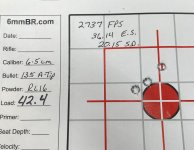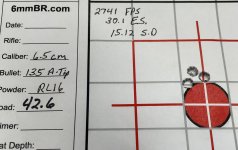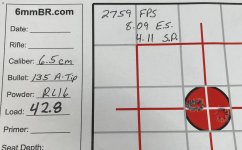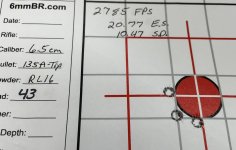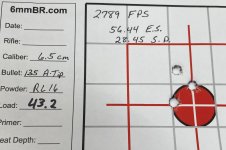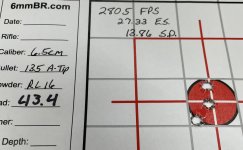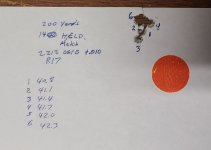Trying this again with more information that will hopefully help clarify some things.
Rifle and Setup -
Bergara B-14 HMR barreled action in a KRG Bravo Chassis
Nightforce NXS 3.5x15, Vortex PMR Rings
RCBS Rockchucker Press
Hornady Brass, Once Fired, 1 Deprimed, 2 Primer Pocket Cleaned, 3 Flash Hole Uniformed, 4 Wet tumbled, 5 Washed and dried, 6 Sized (FL Hornady Matchmaster Die) 0.288" Neck Bushing (giving me about .004" neck tension from my measurements), 7 Trimmed with Hornady LnL Trimmer to 1.920" or just under by a couple of thousands, 8 Case Mouth Deburred in/out
Bullet is the Hornady 135grain A-tip loaded to maximum mag length (I don't have my notes handy for the CBTOg measurement but I know it's 0.086" jump). Loaded with the Hornady Matchmaster Micrometer Die.
Primer - Federal 210
Powder RL16, initial charge dispensed by RCBS Chargemaster and then each verified with a beam-scale and adjusted appropriately to be precise.
Loads - 42.4, 42.6, 42.8, 43, 43.2, 43.4 (Three of each)
LabRadar for the numbers
Shot from a table top with bag supports
See the targets below for more information on FPS, ES, SD, and Group Size
If I missed something, let me know!
Original Post:::
"Question for the SME's! I'm working on a load for my 135gr A-tips in my 6.5cm. I'm running RL16 because it's what I have at the moment and realized I can get faster MV out of RL26 or maybe something else.
Let's just go with what I have rather than "use this" or "use that".
Based on the numbers and group sizes, which would you choose to run with?
Yes Shooter error could account for some deviation on either group (like the one shot to the right on 42.8).
I have the bullets loaded as long as I can possibly get with the mag length and already having to dremel out a spot in the feed ramp area to clear the tip of the bullet. With that tidbit of information I still have about 0.086" jump with the long chamber apparently.
Thoughts?"
Rifle and Setup -
Bergara B-14 HMR barreled action in a KRG Bravo Chassis
Nightforce NXS 3.5x15, Vortex PMR Rings
RCBS Rockchucker Press
Hornady Brass, Once Fired, 1 Deprimed, 2 Primer Pocket Cleaned, 3 Flash Hole Uniformed, 4 Wet tumbled, 5 Washed and dried, 6 Sized (FL Hornady Matchmaster Die) 0.288" Neck Bushing (giving me about .004" neck tension from my measurements), 7 Trimmed with Hornady LnL Trimmer to 1.920" or just under by a couple of thousands, 8 Case Mouth Deburred in/out
Bullet is the Hornady 135grain A-tip loaded to maximum mag length (I don't have my notes handy for the CBTOg measurement but I know it's 0.086" jump). Loaded with the Hornady Matchmaster Micrometer Die.
Primer - Federal 210
Powder RL16, initial charge dispensed by RCBS Chargemaster and then each verified with a beam-scale and adjusted appropriately to be precise.
Loads - 42.4, 42.6, 42.8, 43, 43.2, 43.4 (Three of each)
LabRadar for the numbers
Shot from a table top with bag supports
See the targets below for more information on FPS, ES, SD, and Group Size
If I missed something, let me know!
Original Post:::
"Question for the SME's! I'm working on a load for my 135gr A-tips in my 6.5cm. I'm running RL16 because it's what I have at the moment and realized I can get faster MV out of RL26 or maybe something else.
Let's just go with what I have rather than "use this" or "use that".
Based on the numbers and group sizes, which would you choose to run with?
Yes Shooter error could account for some deviation on either group (like the one shot to the right on 42.8).
I have the bullets loaded as long as I can possibly get with the mag length and already having to dremel out a spot in the feed ramp area to clear the tip of the bullet. With that tidbit of information I still have about 0.086" jump with the long chamber apparently.
Thoughts?"
Attachments
Last edited:

